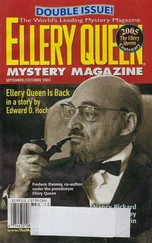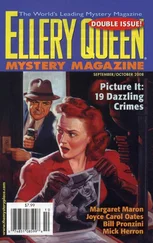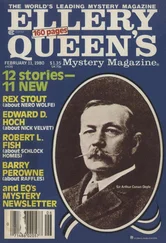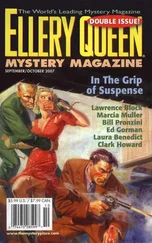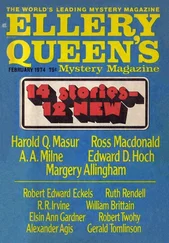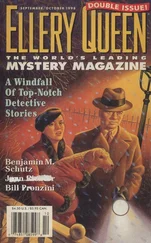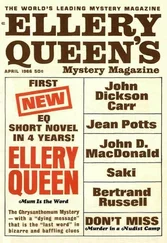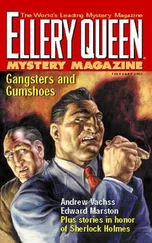Robert Barnard - Ellery Queen’s Mystery Magazine. Vol. 135, No. 2. Whole No. 822, February 2010
Здесь есть возможность читать онлайн «Robert Barnard - Ellery Queen’s Mystery Magazine. Vol. 135, No. 2. Whole No. 822, February 2010» весь текст электронной книги совершенно бесплатно (целиком полную версию без сокращений). В некоторых случаях можно слушать аудио, скачать через торрент в формате fb2 и присутствует краткое содержание. Город: New York, Год выпуска: 2010, Издательство: Dell Magazines, Жанр: Детектив, на английском языке. Описание произведения, (предисловие) а так же отзывы посетителей доступны на портале библиотеки ЛибКат.
- Название:Ellery Queen’s Mystery Magazine. Vol. 135, No. 2. Whole No. 822, February 2010
- Автор:
- Издательство:Dell Magazines
- Жанр:
- Год:2010
- Город:New York
- ISBN:нет данных
- Рейтинг книги:3 / 5. Голосов: 1
-
Избранное:Добавить в избранное
- Отзывы:
-
Ваша оценка:
- 60
- 1
- 2
- 3
- 4
- 5
Ellery Queen’s Mystery Magazine. Vol. 135, No. 2. Whole No. 822, February 2010: краткое содержание, описание и аннотация
Предлагаем к чтению аннотацию, описание, краткое содержание или предисловие (зависит от того, что написал сам автор книги «Ellery Queen’s Mystery Magazine. Vol. 135, No. 2. Whole No. 822, February 2010»). Если вы не нашли необходимую информацию о книге — напишите в комментариях, мы постараемся отыскать её.
Ellery Queen’s Mystery Magazine. Vol. 135, No. 2. Whole No. 822, February 2010 — читать онлайн бесплатно полную книгу (весь текст) целиком
Ниже представлен текст книги, разбитый по страницам. Система сохранения места последней прочитанной страницы, позволяет с удобством читать онлайн бесплатно книгу «Ellery Queen’s Mystery Magazine. Vol. 135, No. 2. Whole No. 822, February 2010», без необходимости каждый раз заново искать на чём Вы остановились. Поставьте закладку, и сможете в любой момент перейти на страницу, на которой закончили чтение.
Интервал:
Закладка:
“How did you know the gold would be hidden in the icehouse?” Cromarty asked. “They might just as well have hidden it elsewhere.”
“Might have, yes, but it would have required additional risk. The weight of the gold and the necessity of finding another hiding place also argued against it having been moved elsewhere. As far as they were concerned, it was perfectly secure inside the icehouse until it could be disposed of piecemeal.”
“Are you saying that the icehouse was where the safe was opened?”
“I am. It’s the only place it could have been managed in this region at this time of year.” Quincannon shifted his gaze to Teague. “Do you recall my stating yesterday that the how and the who of the crime were linked?”
“I do.”
“And so they are. Once I determined that the Schneiders were guilty, it was a simple matter of cognitive reasoning to deduce the how.”
“Fancy talk,” Teague said. “Say it in plain English, man. How’d they break into that safe?”
“Strictly speaking, they didn’t. The safe was opened from the inside.”
“From the inside? What the devil are you talking about?”
“The application of a simple law of physics,” Quincannon said. “After the safe had been allowed to chill inside the icehouse, the Schneiders turned it on its back and hammered a wedge into the crack of the door along the bottom edge, the purpose being to widen the crack through to the inside, similar to their objective with the express-office door. Then, using a bucket and a funnel, they poured water into the safe until it was full. The final steps were to seal the crack with hard-drying putty” — he glanced meaningly at the constable as he spoke — “and then pack ice around the safe and cover the whole with straw. The object being to completely freeze the water inside.”
Newell, the engineer, clapped his hands. “Of course! Water expands as much as one-seventh of its volume when it freezes.”
“Exactly. When the water in the safe froze, the intense pressure from the ice caused the door’s hinges to give way. It was a simple matter, then, for them to chip out the ice and remove the gold. Whatever residue remained in the safe melted after they carried it away to the field.”
Quincannon stood basking in the further approbation that followed these explanations. It was only fitting, of course, for once again he had solved the seemingly insoluble. Superior detective work was a combination of intelligence, observation, deductive reasoning, and supreme self-confidence. These qualities, which he possessed in abundance, made him the most celebrated sleuth west of the Mississippi River. Any man who didn’t agree with that assessment was a dunderhead.
Marshal James B. Halloran of Jamestown, for instance.
Quincannon chuckled evilly to himself. Halloran, all unwittingly, had provided him with one other clue to the solution of this case — one he hadn’t mentioned in his summation. He was saving it to use as part of his gloat when he sought out that dunderhead marshal before leaving the Queen of the Mines.
“You may be a fancy-pants detective in San Francisco,” Halloran had said in Cromarty’s office, “but you don’t cut no ice up here.” Ah, but he had — figuratively if not literally. He’d cut more ice in Tuttletown last night, by godfrey, than the Schneiders had inside that so-called burglarproof safe!
Copyright © 2010 Bill Pronzini
The Jury Box
by Jon L. Breen
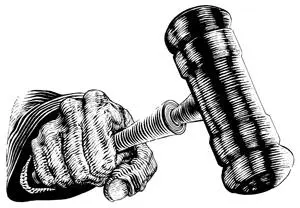
The year just past has been an unusually strong one for Baker Street aficionados. The Sherlock Holmes Reference Library added a volume of Sir Arthur Conan Doyle’s extra-canonical writings, The Apocrypha of Sherlock Holmes (Gasogene, $19.95), edited and fulsomely annotated by Leslie S. Klinger. Included are two brief comic vignettes, two tales in which Holmes arguably appears as an anonymous writer of letters to the editor, three stage plays, and an unrealized plot outline that may not (per Daniel Stashower’s introduction) be an authentic work of Watson or Doyle.
The two-CD set Voices from Baker Street (Wessex Press, $18.95) re-issues rare recordings of Sherlockian events from the 1950s to early 1980s, high-spirited and humorous for the most part, including the voices of such luminaries as Vincent Starrett, Anthony Boucher, Rex Stout, Isaac Asimov, and Basil Rathbone. A mock radio broadcast of Silver Blaze’s Wessex Plate race by famed sportswriters Red Smith and Joe Palmer is especially memorable.
Non-British pastiche writers sometimes relocate Holmes to their own countries. Among the writers given that patriotic assignment in Sherlock Holmes in America (Skyhorse, $24.95), edited by Martin H. Greenberg, Jon Lellenberg, and Daniel Stashower, are Texan blog columnist Bill Crider and your Californian juror. Coincidentally, we both brought Holmes to (where else?) Chicago. Sherlock Holmes in Russia (Robert Hale/Trafalgar, $24.95), edited and translated by Alex Auswaks, presents seven early-20th-century tales by Russian writers.
The Improbable Adventures of Sherlock Holmes (Night Shade, $15.95) gathers editor John Joseph Adams’s picks of the best pastiches of the past thirty years, a mixed bag with a little too much supernatural stuff for some tastes but a distinguished roster of contributors, including Stephen King, Anne Perry, Sharyn McCrumb, Laurie R. King, and Michael Moorcock. The 65-page “Watson!” and Other Unauthorized Sherlock Holmes Pastiches, Parodies, and Sequels (Wildside, $4.99) consists of the title story by Captain A.E. Dingle, and other early-20th-century takeoffs by G. F. Forrest, Bret Harte, O. Henry, and John Kendrick Bangs.
The first of the great book-length pastiches, H.F. Heard’s 1941 novel A Taste for Honey, in which Sherlock takes up beekeeping under the alias Mr. Mycroft, has been reprinted in a new edition (Blue Dolphin, $16.95), with a foreword by Stacy Gillis and an afterword by John Roger Barrie, Heard’s literary executor. Joining this classic as one of the best dozen or so extra-canonical novels is the first from a new star on the scene.
**** Lyndsay Faye: Dust and Shadow, Simon & Schuster, $25. Of the many attempts to involve Holmes with Jack the Ripper, this is probably the best. Dr. Watson, whose narrative style is well captured, is happily depicted as more heroic than comic, and the sleuth himself is at his most intellectually keen and personally complex. The facts of the crimes are depicted in careful, scholarly fashion, and the well-managed ending reprises a viable theory of how the Ripper might have avoided detection. (Faye also leads off Sherlock Holmes in America, referenced above, with a fresh look at “The Case of Colonel Warburton’s Madness.”)
**** Donald Thomas: Sherlock Holmes and the King’s Evil, Pegasus, $25. Supreme among the pastiche writers, Thomas includes more history and detailed detective work, often from physical evidence, than almost anyone. Most of the stories have their origin in real events, culminating in World War I cryptography and espionage in “The Case of the Zimmermann Telegram.” Other stories concern forged manuscript detection, lighthouse management, and fingerprint evidence, which gets an unusual treatment in “The Case of the Tell-Tale Hands,” based on Oscar Wilde’s “Lord Arthur Savile’s Crime.”
**** Gyles Brandreth: Oscar Wilde and the Dead Man’s Smile, Touchstone, $14. Speaking of Wilde, his third outing as fictional detective concerns a series of murders, some borderline locked rooms, in the circle of a French theatrical family. Though the principal events occur in the early 1880s, a framing story set a decade later invites his friend Conan Doyle’s participation in the detection and includes the speculation that Wilde was the model for Mycroft Holmes. The prose and dialogue are first rate, and Oscar’s final summing up is as close in spirit and intricacy to one of Ellery Queen’s as you’ll find in the current market.
Читать дальшеИнтервал:
Закладка:
Похожие книги на «Ellery Queen’s Mystery Magazine. Vol. 135, No. 2. Whole No. 822, February 2010»
Представляем Вашему вниманию похожие книги на «Ellery Queen’s Mystery Magazine. Vol. 135, No. 2. Whole No. 822, February 2010» списком для выбора. Мы отобрали схожую по названию и смыслу литературу в надежде предоставить читателям больше вариантов отыскать новые, интересные, ещё непрочитанные произведения.
Обсуждение, отзывы о книге «Ellery Queen’s Mystery Magazine. Vol. 135, No. 2. Whole No. 822, February 2010» и просто собственные мнения читателей. Оставьте ваши комментарии, напишите, что Вы думаете о произведении, его смысле или главных героях. Укажите что конкретно понравилось, а что нет, и почему Вы так считаете.

